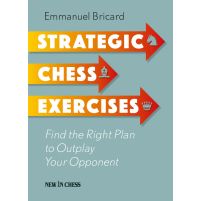Back in 2020 New In Chess published Strategic Chess Exercises written by Emmanuel Bricard.
It is a practical exercise manual with carefully selected and tested training positions that teach you how to develop the right plan.
This September, Ben Johnson – in his Book Recap on the Perpetual Chess Podcast – reviewed the book together with a returning guest, Dr. Michael Franco, who is a Software Engineer and fast-improving amateur player, who is active in various online chess communities.
They both were very enthusiastic about the book and even called it a Hidden Gem. Here are some quotes from the podcast which you can listen to in full if you’d like.
Franco: “What I really like about the book is that it cuts to the core of what it takes to improve your position. It teaches you how to evaluate a position and focus on its key factors. The solutions to each of these 90 exercises start with the right moves, before transitioning to a full annotated analysis of the rest of the game. These are all games from famous players, from Steinitz to Korchnoi to Kasparov. You get GM-level annotations of interesting games, that are not necessarily well-known, and a bunch of interesting highlighted positions that you can improve your chess with. For each of the themes that the author shows, the model game really is the perfect example. After finishing an exercise and looking back on the position with knowledge and insight from the grandmaster, you will know what type of idea to look for in which type of position.”
They both agreed that the material was excellent and they were impressed by the fact how well the positions were checked by the engine.
Franco: “The positions are very well-chosen. They’re challenging without being inaccessible, cutting deeply into what is required to actually improve, being able to evaluate them correctly, and finding the right plan or move. I genuinely feel like I improved a lot by going through this book. The annotations sometimes devolve into interesting analyses of alternate lines, for example of a king and pawn endgame that could have arisen. You can choose to skip these analyses completely, but it’s kind of fun. The book is presented as 90 exercises, but there’s so much more to it than just those 90 positions. You get what you put in.”
Johnson: “Greatly instructive. It’s primarily positional puzzles, where to put your pieces, and how to take advantage of weaknesses in the enemy’s camp, but it’s also very concrete, meaning a lot of variations where the author really tries to account for every move in every position. There is calculation involved in terms of the positional puzzles, but there are some tactical lines as well.”
Both concluded that “it’s not an easy book”. “It’s challenging but extremely informative”, both reviewers agreed.
If you put some effort in, this book can greatly improve your strategic chess!
